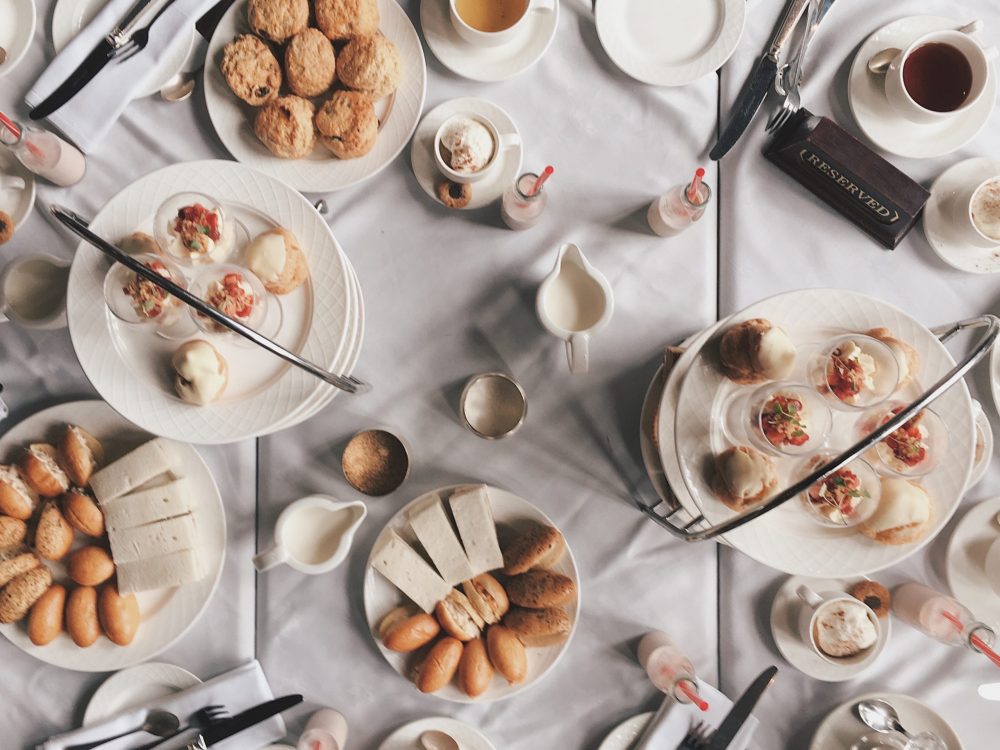When it comes to tea etiquette, whether it be afternoon tea, high tea, or any of the other ‘tea times’, it can be difficult to keep up! What does high tea time mean? And why is it called high tea? Is it the same as afternoon tea or is there a difference?
In this article, we’re going to answer these questions and more, including who started high tea. Hopefully, by the time you’ve finished reading this piece, you should have a better understanding of high tea, how it varies from afternoon tea, and whether or not it’s something that you’d like to try for yourself!

What does high tea time mean?
So, what does high tea time mean? Not to be confused with afternoon tea, high tea is something that is served later and is much more substantial in terms of nourishment.
Afternoon tea was a sort of bridge between lunch and dinner. As most evening meals wouldn’t be served until 8 pm (back in the mid to late 1700s) many of the upper classes would decide to sit and take a light lunch with tea during the afternoon.
High tea, on the other hand, came much later and was more geared toward the lower classes who couldn’t afford to sit around in the afternoon eating fancy cakes and drinking tea. Instead, high tea was a late dinner, served from 6 pm to 8 pm, and typically involved a mug of tea, bread, cheese, vegetables, and occasionally meat (depending on availability and how ‘well-off’ the family was).
Some families with a bit more money would add pies, potatoes, meat, and crackers.
So, to differentiate between afternoon tea and high tea, think of afternoon tea as an indulgent social event for the upper classes; whereas high tea was a necessary meal for the working class who would return home late, famished and desperate for a substantial meal before going to bed and starting their working day all over again.

Why is it called high tea?
There is much speculation as to why it is called high tea. It could be because high tea was typically served in the latter part of the evening. However, most people speculate that it was because high tea was eaten at a dinner table.
Afternoon tea tends to be taken whilst the upper classes were reclining in low, comfortable chairs and/or sofas. High tea, on the other hand, favoured by the lower classes, would be sat at their dinner table, on high chairs or stools, at the latter part of the day.
This is why there is a lot of confusion about high tea because again, the name implies a fancy occasion and brings forth images of elevated pinkie fingers and floppy floral hats.
Naturally, it wasn’t long before the upper classes developed their own variation of ‘high tea’. This was typically when their servants were either away, or unavailable to prepare dinner. In which case, high tea was a quick and easy meal to prepare, with a pot of tea, some salmon and/or pigeon, veal, and fruit.
Today, afternoon tea is often referred to as high tea in other parts of the world, outside the UK. This is why there are so many conflicting articles about this to be found on the internet. After all, high tea sounds much more appealing than afternoon tea—as such, many establishments will typically advertise afternoon tea as high tea. Some places, on the other hand, offer the two.
However, as we are talking about the origins of high tea, it is important to recognise the difference between the two. 
Who started high tea?
The name high tea time implies a fancy tea, but contrary to popular belief, high tea was geared more towards the lower classes. You will find much confusion as to who started high tea because it was Anna, the Seventh Duchess of Bedford who coined the term ‘afternoon tea’. As such, many people say that it was Anna who started high tea, but this was not the case.
Anna, the Seventh Duchess of Bedford introduced afternoon tea in England, during the year 1840, because she would become hungry around 4 pm. As the evening meal in her home was served much later, at some 8 pm, there would be a long period between lunch and dinner. As such, she decided to take tea and cakes at 4 pm to tide her over and bridge the gap between lunch and dinner.
Again, the upper classes developed their own version of high tea eventually, but to answer the question: “who started high tea?” – it was the lower classes.
High tea was exclusively served in working-class households when workers would return home from their factory shifts (often around 6 pm), and then a substantial dinner would be served, with a pot of tea. As tea was rather expensive at the time, tea was reserved for this time in the evening and served with as much food and nutrition as the family could afford.
Additionally, fancy teaware is something that would have been exclusively reserved for the upper classes. As for the working class, their pots of tea would have been significantly less decorative. Fortunately, today, gorgeous teaware, such as Yvonne Ellen’s teaware collection is widely available and not strictly reserved for the ‘ultra-posh’.
Again, speculation dictates that high tea was coined due to the fact that it was served at a dinner table. Though it could also be due to the fact that it was served in the latter part of the evening.
Conclusion
And there it is: high tea was originally a later meal served with tea for (and coined by) the working class. Today, it is readily available to anyone who fancies some delicious cakes and a hot pot of tea with some friends.




















